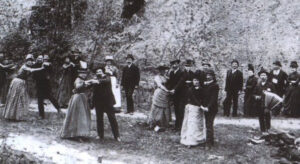
When the dancers start busting their moves at the up-coming Woodstock 50th Anniversary Dance Party at Crown Hall on August 17th, they will not only be celebrating the golden jubilee of that iconic rock festival, but also taking their places in a long line of hoofers who have dipped and twirled in many Mendocino halls and ballrooms for over 150 years. From the waltzes of the Victorian era and the foxtrots of the Twenties, to the boogies of the 1970s and the tangos and zumbas of today, this has been a town that loves to dance.
The first ballroom was established in 1857 in the City Hotel by J. E. Carlson, a Swede who had worked at the mill for a few years and decided he wanted different work. On land he purchased from William Kelley at the west end of Main Street, he built a three-story hotel that had “an elegant dining room, superior fare, a custom-made billiard table,” and a ballroom on the third floor. People worked hard for six days, but on the eve of the seventh, they danced.
After the devastating fire of 1870 wiped out more than 20 buildings on Main Street, J. D. Murray rebuilt his drug store near where Sol de Mendocino is now. The social hall on the second-floor hosted parties and dances, and also served as the Odd Fellows meeting place until they built their own hall in 1879 on the southwest corner of Kasten and Ukiah Streets, where it still stands. There, too, evening and afternoon dances were popular well into the twentieth century.
A couple of years before that, in 1877, William Kelley got into the hall business himself when he built a skating rink on the corner of Lansing and Kasten (currently Rainsong Clothing). Such a large space was also perfect for dances, as well as basketball games and boxing matches. His daughter Daisy MacCallum completely remodeled it as Kellieowen Hall in the 1950s and the dancing stopped there in favor of more sedate meeting rooms and a public library.
Two of Mendocino’s more splendid dance venues were unceremoniously demolished in the 1940s and early 1950s, after the mill closed and the town fell into its slumber. The second Odd Fellows Hall, built in 1894 kitty-corner from the first one on Ukiah Street, was universally praised for its superior second-story dance floor. The timber flexed with a large group moving across it, providing the kind of bounce dancers loved. Just to the north, where the Baptist Church is now located on the corner of Little Lake and Kasten, the Apple Hall was constructed in 1912 to hold the annual Apple Fair, but frequently served as display hall, convention space, dance emporium, and basketball court.
When the large local Portuguese community wanted a place for its social activities and religious festivities, it raised the funds to put up Crown Hall in 1902 on the west end of Ukiah Street. In the Kelley House archives, we found a 1905 notice for a social dance at the hall that invited men to attend for 50 cents and women to enter at no cost. With its large open floorplan, stage, bar, and kitchen, Crown Hall has accommodated many celebrations in its day, and is the only space in Mendocino—from any era—still in the dance business.
Two of the legendary venues of the 70s and 80s—Toad Hall and the Caspar Inn—are, alas, no longer in the boogie business, but they live on in our memories and on Super 8 film (now digitized at the Kelley House). Originally a road house on the Comptche-Ukiah Road called the Pine Ridge Lodge, it became Toad Hall in the early 70s as a venue for big-name musicians and groups and for colossal boogies in its meadow. At a time when hippie music could be heard only in small cafes, and dances had to be held in friendly pastures, Lee Larsen White joined Donna and Patsy Brown in making the place what White recalls was a “nightclub of sorts,” where “a regular night was loud, raucous, smoky, and dusty, with lots of folks drinking a bit too much.”
Nights were similar at the Caspar Inn, another roadhouse from 1906, which Peter Lit and a partner resuscitated in the late 70s and turned into a place to enjoy great music “up close and loud” while “dancing your booties off.” For 30 years, it was a rocking music scene, but on a sad day in February of 2013 it closed.
However, it’s best not to dwell on past glories and mourn lost wonderlands; it’s better to get up, go out, and bop til you drop at the Woodstock 50th Anniversary Dance Party at the venerable Crown Hall on Saturday, August 17th. Tickets are $20 in advance ($25 at the door) and on sale at Harvest Market in Fort Bragg, and at Out of This World and the Kelley House in Mendocino. All proceeds benefit the Kelley House Museum and its programs. Call 707/937-5791 or email us at info@kelleyhousemuseum.org. Be sure to wear your bell bottoms!